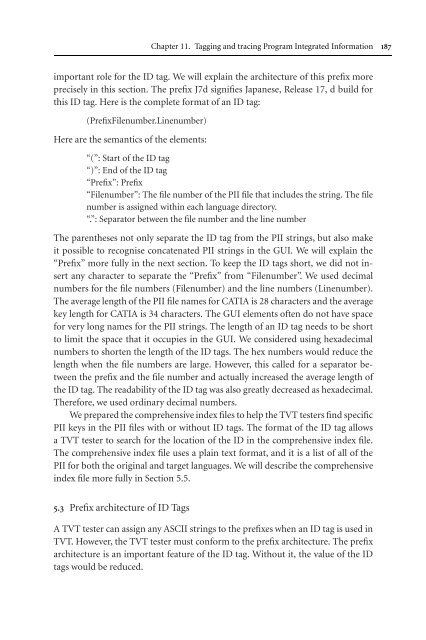Topics in Language Resources for Translation ... - ymerleksi - home
Topics in Language Resources for Translation ... - ymerleksi - home
Topics in Language Resources for Translation ... - ymerleksi - home
- No tags were found...
Create successful ePaper yourself
Turn your PDF publications into a flip-book with our unique Google optimized e-Paper software.
Chapter 11. Tagg<strong>in</strong>g and trac<strong>in</strong>g Program Integrated In<strong>for</strong>mation 187important role <strong>for</strong> the ID tag. We will expla<strong>in</strong> the architecture of this prefix moreprecisely <strong>in</strong> this section. The prefix J7d signifies Japanese, Release 17, d build <strong>for</strong>this ID tag. Here is the complete <strong>for</strong>mat of an ID tag:(PrefixFilenumber.L<strong>in</strong>enumber)Here are the semantics of the elements:“(”: Start of the ID tag“)”: End of the ID tag“Prefix”: Prefix“Filenumber”: The file number of the PII file that <strong>in</strong>cludes the str<strong>in</strong>g. The filenumber is assigned with<strong>in</strong> each language directory.“.”: Separator between the file number and the l<strong>in</strong>e numberThe parentheses not only separate the ID tag from the PII str<strong>in</strong>gs, but also makeit possible to recognise concatenated PII str<strong>in</strong>gs <strong>in</strong> the GUI. We will expla<strong>in</strong> the“Prefix” more fully <strong>in</strong> the next section. To keep the ID tags short, we did not <strong>in</strong>sertany character to separate the “Prefix” from “Filenumber”. We used decimalnumbers <strong>for</strong> the file numbers (Filenumber) and the l<strong>in</strong>e numbers (L<strong>in</strong>enumber).The average length of the PII file names <strong>for</strong> CATIA is 28 characters and the averagekey length <strong>for</strong> CATIA is 34 characters. The GUI elements often do not have space<strong>for</strong> very long names <strong>for</strong> the PII str<strong>in</strong>gs. The length of an ID tag needs to be shortto limit the space that it occupies <strong>in</strong> the GUI. We considered us<strong>in</strong>g hexadecimalnumbers to shorten the length of the ID tags. The hex numbers would reduce thelength when the file numbers are large. However, this called <strong>for</strong> a separator betweenthe prefix and the file number and actually <strong>in</strong>creased the average length ofthe ID tag. The readability of the ID tag was also greatly decreased as hexadecimal.There<strong>for</strong>e, we used ord<strong>in</strong>ary decimal numbers.We prepared the comprehensive <strong>in</strong>dex files to help the TVT testers f<strong>in</strong>d specificPII keys <strong>in</strong> the PII files with or without ID tags. The <strong>for</strong>mat of the ID tag allowsa TVT tester to search <strong>for</strong> the location of the ID <strong>in</strong> the comprehensive <strong>in</strong>dex file.The comprehensive <strong>in</strong>dex file uses a pla<strong>in</strong> text <strong>for</strong>mat, and it is a list of all of thePII <strong>for</strong> both the orig<strong>in</strong>al and target languages. We will describe the comprehensive<strong>in</strong>dex file more fully <strong>in</strong> Section 5.5.5.3 Prefix architecture of ID TagsA TVT tester can assign any ASCII str<strong>in</strong>gs to the prefixes when an ID tag is used <strong>in</strong>TVT. However, the TVT tester must con<strong>for</strong>m to the prefix architecture. The prefixarchitecture is an important feature of the ID tag. Without it, the value of the IDtags would be reduced.
















